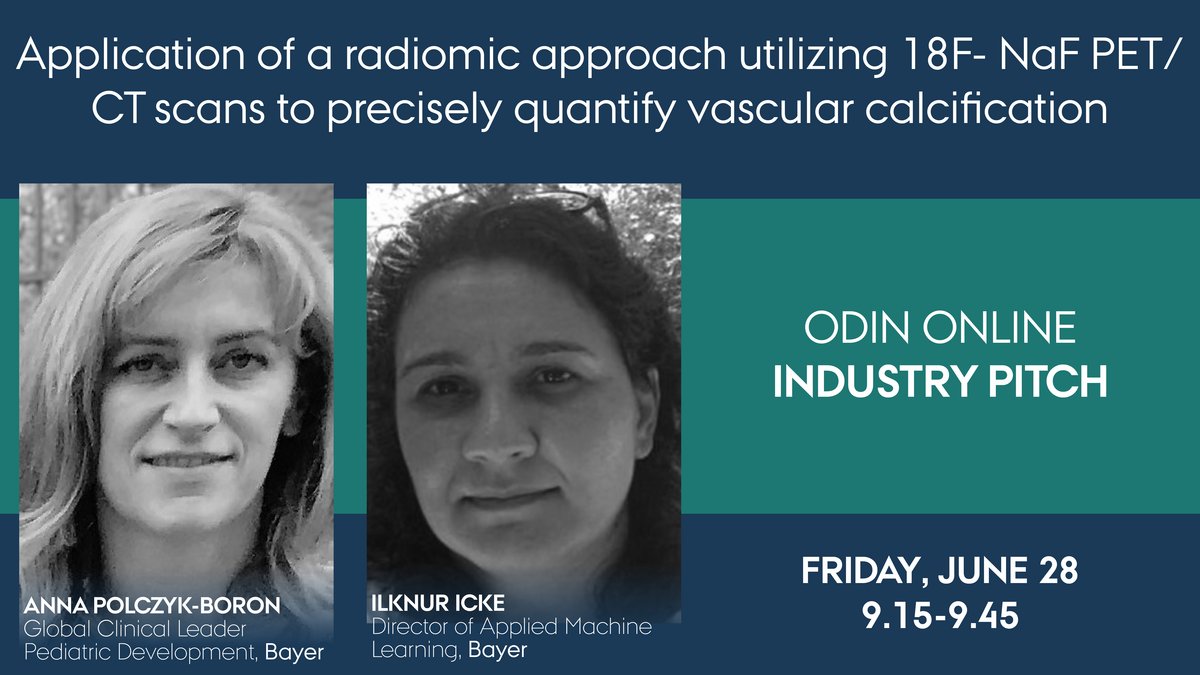ODIN online industry pitch | Bayer
The project idea entitled 'Application of a radiomic approach utilizing 18F- NaF PET/CT scans to precisely quantify vascular calcification.' will be presented by Anna Polczyk-Boron and Ilknur Icke from Bayer.
Info about event
Time
Location
online
Organizer
Soft tissue calcification, including vascular calcification, is a major global health problem associated with significant morbidity, mortality, and costs. A major impediment to progress in the study and treatment has been a lack of tools to precisely identify disease burden and quantify effects of treatment on active disease in the timeframe of clinical trials of feasible length. 18F Na PET/CT scanning coupled with the radiomics Machine Learning assistant may be a solution.
The primary constituent and the hallmark of pathologic calcification is hydroxyapatite – the building block of the biological crystal that makes up physiologic and pathologic calcifying tissues. Radiolabeled fluoride (F-) can substitute for the hydroxyl group (OH-) to form fluorapatite.
18F- NaF PET/CT scans can very precisely quantify both active 18F uptake by PET, which detects the volume and intensity of active calcification (microcalcification), as well as the volume and density of formed areas of calcification by CT (macrocalcification). Physiologically, microcalcification precedes macrocalcification and identifies active disease.
NIH utilized 18F NaF PET/CT imaging to study a cohort of patients, both pediatric and adult, with the rare disease of pathological calcification, hyperphosphatemic familial tumoral calcinosis. NIH developed a precise 18F NaF PET/CT scan-based technique to quantify soft tissue and vascular calcification also allowing for direct patient to patient comparison (DOI: 10.1161/ATVBAHA.123.320455). Bayer proposes applying ML to the radiomic NIH dataset to validate and expand the technique to support not only 18F- NaF PET/CT molecular imaging biomarker and clinical endpoint workflows applied to R&D in the field of diseases with calcifications and radioisotope programs.
Using this technique will allow in clinical trials to focus efficacy assessment to actively calcifying lesions, which are more likely to respond to treatment and exclude from analysis inactive lesions, not likely to respond, thus minimizing the potential for a type 2 error. With the 18F NaF PET/CT technique and the radiomics, we aim to develop and subsequently validate a quantitative diagnostic and prognostic imaging biomarker in vascular calcifications. Once the biomarker is validated and published it could be used for all subsequent development programs across the industry and could help in clinical diagnostics and radioisotope therapeutics. Our initiative aims to redefine and boost the diagnostics and treatments in vascular calcifications. We invite partners interested in ectopic calcifications seeing the opportunity for this technique to become a breakthrough in calcification research and development, to join us in this innovative initiative.
Acknowledgement: Bayer team presenting the work being done in cooperation with NIH NIDCR, Bethesda, MD, US and based on the NIH NIDCR data under the leadership of Dr. Michael Collins
